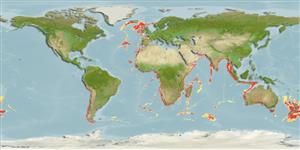Elasmobranchii (sharks and rays) >
Squaliformes (Bramble, sleeper and dogfish sharks) >
Somniosidae (Sleeper sharks)
Etymology: Centroscymnus: Greek, kentron = sting + Greek, skymnos, -ou = pup, puppy (Ref. 45335).
Issue
As Centroselachus crepidater in Ref. 58085:113; please send taxonomic reference(s) to confirm genus placement.
Environment / Climate / Range
Ecology
Marine; bathydemersal; depth range 230 - 1500 m (Ref. 26346). Deep-water, preferred 23°C (Ref. 107945); 64°N - 57°S, 77°W - 159°W
Eastern Atlantic: Iceland, Faeroe Islands along Atlantic slope to Portugal, Senegal, Madeira, Gabon to Democratic Republic of the Congo, Namibia. Indian Ocean: Aldabra and the Travancore coast of India. Western Pacific: New South Wales, Australia and New Zealand. Southeast Pacific: northern Chile.
Length at first maturity / Size / Weight / Age
Maturity: Lm 75.4, range 82 - ? cm
Max length : 130 cm TL male/unsexed; (Ref. 6577); max. reported age: 54 years (Ref. 57506)
Dorsal
spines
(total): 2;
Dorsal
soft rays
(total): 0;
Anal
spines: 0;
Anal
soft rays: 0. Black or blackish brown in color, dorsal fins with very small fin spines, very long snout, greatly elongated labial furrows that nearly encircle mouth, lanceolate upper teeth and bladelike lower teeth with moderately long, oblique cusps, fairly slender body that does not taper abruptly from pectoral region, moderately large lateral trunk denticles with partly smooth, oval, cuspidate crowns in adults and subadults (Ref. 247).
A fairly common species found on continental and insular slopes (Ref. 6871), on or near the bottom (Ref. 5578). Feeds mainly on fish and cephalopods (Ref. 6871). Ovoviviparous (Ref. 205), with 4-8 young in a litter (Ref. 6871), born at 28-35 cm (Ref. 26346). The flesh is high in mercury; utilized as fishmeal and source of squalene (Ref. 6871).
Ovoviviparous, with 4-8 young in a litter (Ref. 6871). Born at 28-35 cm (Ref. 26346). Distinct pairing with embrace (Ref. 205).
Compagno, L.J.V., 1984. FAO Species Catalogue. Vol. 4. Sharks of the world. An annotated and illustrated catalogue of shark species known to date. Part 1 - Hexanchiformes to Lamniformes. FAO Fish. Synop. 125(4/1):1-249. Rome, FAO. (Ref. 247)
IUCN Red List Status (Ref. 115185)
CITES (Ref. 94142)
Not Evaluated
Threat to humans
Poisonous to eat (Ref. 6871)
Human uses
Fisheries: minor commercial
More information
ReferencesAquacultureAquaculture profileStrainsGeneticsAllele frequenciesHeritabilityDiseasesProcessingMass conversion
Tools
Special reports
Download XML
Internet sources
